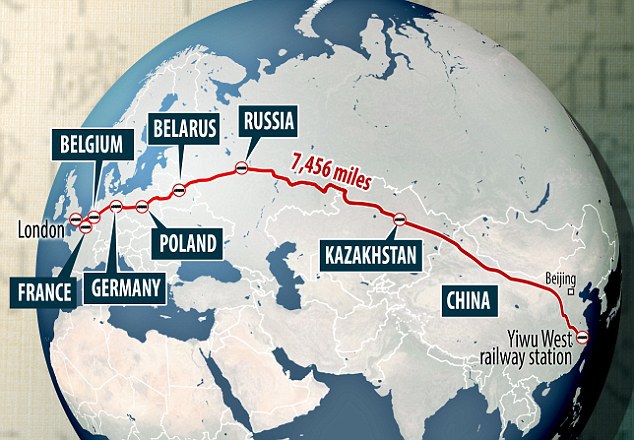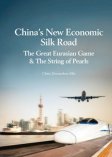Russia’s Eurasian Economic Union Free Trade Agreement with Beijing Brings Chinese Goods to the EU Border


The Free Trade Agreement (FTA) that China signed off last week with the Eurasian Economic Union is going to develop to be a game-changer in Eurasian trade, including with the European Union. To recapitulate, the Eurasian Economic Union was formed on January 1, 2015 and is a trade bloc that currently includes Armenia, Belarus, Kazakhstan, Kyrgyzstan, and Russia. Oft cited as “Russia’s answer to the EU”, it remains little understood and has been somewhat ignored by Western businesses. While many international companies interact with China, there remains an ignorance of the EAEU. That is a mistake as developments within it have the potential to shake up and alter European trade flows between the EU and China and possibly to India and ASEAN as well. The EAEU comes right up to the EU border via Belarus, and it borders with Latvia, Lithuania and most significantly, Poland. In addition to this, Moldova has just become an observer nation with a view to later membership, which also provides a border to the EU via Romania. All possess huge investment potential as a result of the potential for Chinese involvement with the EAEU and EU access.
Collectively the EAEU may appear at first glance to be a miniature recreation of the old Soviet bloc. Such views are misleading. The EAEU has a combined population of 183 million, (about the same size as three United Kingdoms) a GDP (PPP) of over US$4 trillion, and a per capita nominal income of US$13,150, just slightly lower than that of China. If it were a country, in GDP terms it would be the world’s fourth largest economy, just behind Japan but ahead of Germany. The EAEU is also proving something of a success – intra-EAEU trade was up 30 percent in 2017.
It is for these reasons that numerous other countries have applied for FTAs with the EAEU. Among them are India, Singapore, and Turkey as part of 40 countries currently involved in FTA negotiations. Iran has also just agreed to an FTA with the EAEU.
Of these, the now signed China-EAEU FTA is among the most interesting. While much Western media attention has played on the China “East Wind” trains that have sped from Yiwu through to now 15 European Rail Freight Terminals, it has not been recognized that now that a China-EAEU FTA has been reached, Chinese goods are effectively able to cross the entire Eurasian land mass duty free, and turn up right on the EU’s borders. Agreed administrative measures designed to facilitate this trade are part of the FTA, and new technologies such as blockchain will also play a role in improved logistical efficiencies.
This improved connectivity is because the EAEU includes Kazakhstan, Russia, and Belarus, and will later include Moldova, as members, and is the primary routing for rail freight services to Europe. From there, goods are distributed across the European Rail network as far away as Madrid and London. Theoretically, once the goods are in the EU, they can be sent by freight to any railway station within the Union, and beyond.
Further down the development pipeline between China, Russia, and the European Union is the Northern Sea Passage route, which will see traffic between China and Europe via the Arctic Ocean. That is intended to link with rail developments in Finland, Sweden, and the Baltic States while other rail links Russian ports to Finland and Norway. The upgrading of Russian ports along the Northern Passage is already taking place, often with Chinese funding. The route is also partially open – Russia exported LNG gas from the Arctic to India for the first time in a Chinese Silk Road funded deal just a few weeks ago.
The agreement between China and the EAEU over free trade will have a significant impact on the EU. Goods identified within such an agreement will be primary products for export to the EU. Retail prices are likely to drop, meaning increased competition for EU manufacturers making similar products, while there is huge development potential for logistics, warehousing, and related services either side of the Belarus-EU borders. The largest of these is the Belarus/Poland border, and is marked by several crossings, of which the Brest-Terespol crossing is the largest. This is home to the main railway line connecting through to Berlin and Moscow, as well as the E30 European Route by road. These routes essentially link the European Union with the Commonwealth of Independent States, and thus the EAEU.
There are complications. Brest is where the the Russian broad gauge rail meets the European standard gauge, meaning all trains must have their bogies replaced, and freight must be transloaded from cars of one gauge to cars of another.
There are additional links to the EU between Belarus and Latvia at Bigosovo and Indra; and with Lithuania at Benyakoni and Stasilos as well as between Gudogay and Kena. All these locations are likely to experience significant Chinese investment and interest should the date of the proposed China-EAEU FTA start to move closer. EU investors from Latvia, Lithuania, Poland, and Romania should be keeping a close eye on developments, while the Belorussians, Chinese, and Russians will be wanting to invest on the EAEU side. Commercial property investors could be set for a field day. Meanwhile, EU based manufacturers of goods and products already made in China or the EAEU need to be thinking about how long they can sustain production costs in the EU. They will need to relocate production to China or the EAEU or face extinction. However, one thing is apparent: the Chinese ability to conduct free trade will shift over 6,000 km west to nudge right up against the EU. The implications of this need to be carefully thought through by EU based businesses.
About Us
Silk Road Briefing is written by Dezan Shira & Associates. The practice provides essential market intelligence, legal, tax, and on-going advisory and administrative services to foreign investors throughout Asia, including China, India, the ASEAN nations, and Russia, and has done so since 1992. Please contact the firm at silkroad@dezshira.com or visit our website at www.dezshira.com
 Related Reading:
Related Reading:
![]() China’s FTA with the EAEU Will Improve Market Access, EU Transhipments
China’s FTA with the EAEU Will Improve Market Access, EU Transhipments
![]() Transhipping China Trains and Ships to Europe – Understanding Russia’s Economic and Trade Performance in 2018 and Beyond
Transhipping China Trains and Ships to Europe – Understanding Russia’s Economic and Trade Performance in 2018 and Beyond
Silk Road and OBOR Business Intelligence
Dezan Shira & Associates´ Silk Road and OBOR investment brochure offers an introduction to the region and an overview of the services provided by the firm. It is Dezan Shira´s mission to guide investors through the Silk Road´s complex regulatory environment and assist with all aspects of establishing, maintaining and growing business operations in the region.
China’s New Economic Silk Road
This unique and currently only available study into the proposed Silk Road Economic Belt examines the institutional, financial and infrastructure projects that are currently underway and in the planning stage across the entire region. Covering over 60 countries, this book explores the regional reforms, potential problems, opportunities and longer term impact that the Silk Road will have upon Asia, Africa, the Middle East, Europe and the United States.







